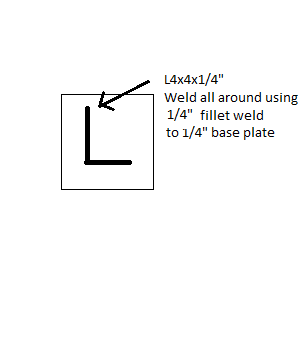You need to take a step back and think really carefully about this.
By your questions, and the elementary way you have phrased them, I want to YOU to challenge YOURSELF about your training and qualifications to design this baseplate and post.
It's a temporary handrail mount on an OSHA-regulated site. That means by definition is is man-rated, life-safety items ... even if it's "only" a temporary handrail post. Guard rails are 42 inches high (not 60!), and must be rated for at minimum 50 lbf sideways at 42 inch lever arm moment arm. Minimum. Now, usually, there is a vertical post every four feet, which is where I suspect your 200 lbf sideways came from. What is the direction of the sideways force on the eccentric angle iron? Why the 60 inch requirement? What happens when two 250 lb millwrights stand on the temporary handrail to reach something?
What is your safety factor, and where is this handrail/guardrail actually going to be installed. (Not by itself certainly!) what is the baseplate mounted to, how close to the edge of the concrete pad (???) is the baseplate, what strength concrete (???), what depth and what cure time? If wood, what is the wood fastened to and how?
Why do you assume two anchor bolts are sufficient for an eccentric load on a baseplate that thin and that small? What sizes holes in the baseplate and how far from the edge are the holes?
Do you have room for bolts and washers?
Your weld "design" seems based on assuming equal area is required between angle iron, weld thickness, and baseplate thickness. That is an approximation valid in some circumstances, but why use it here?

